From Sketches to Spotlight: Bob Mackie Talks with Richard Boch
There are those occasions when the words legend, glamour and genius are overused at the risk of becoming cliché or, at best, an off-handed exclamation without the point. Talking about the costume designer Bob Mackie is definitely not one of those occasions.
I visited the exhibition Bob Mackie: From Sketches to Spotlight at the Soho Grand Gallery a few days after it opened. I stopped by again a week or so later and took the time to really soak it all in. Seeing the sketches that Mackie began working on more than six decades ago, when he was still a kid, and how his creativity and spirit brought him into the present, is to follow a man on a mission that’s become an incredible lifelong journey.
Bob Mackie was in New York City at The Soho Grand for the opening of Sketches to Spotlight. He loves the city but calls Palm Springs home even though Los Angeles is the town where he grew up, built his career, and for Mackie, it’s where it all happened. He was in his early twenties when he found himself assisting the Academy Award-winning costume designer Edith Head. It was a very young Bob Mackie who drew up the original design sketches for couturier Jean Louis that became the dress Marilyn Monroe wore at Madison Square Garden while signing Happy Birthday to President John F. Kennedy in 1962. From there, it wasn’t too long before his reputation began to grow beyond what anyone could have imagined.
Mackie soon came into his own and within a few years was designing costumes, stagewear and gowns for everyone from Diana Ross and The Supremes to Cher, from Carol Burnett to Tina Turner, from Elton John to Madonna. His name and the scope of his incredible work have brought him into the here and now—with stars like Miley Cyrus, Pink and even the wild and wonderful RuPaul, one of Mackie’s biggest fans, all wearing his designs.
I was given Bob’s number and asked to call at 9:00 AM, West Coast time. His design director Joe answered the phone, so I quickly asked if Bob was more comfortable being addressed as Bob or as Mr. Mackie. Apparently, I was already on speaker when I heard a voice shout out, BOB!
That was the beginning of a wonderful conversation. Here’s the rest of it.
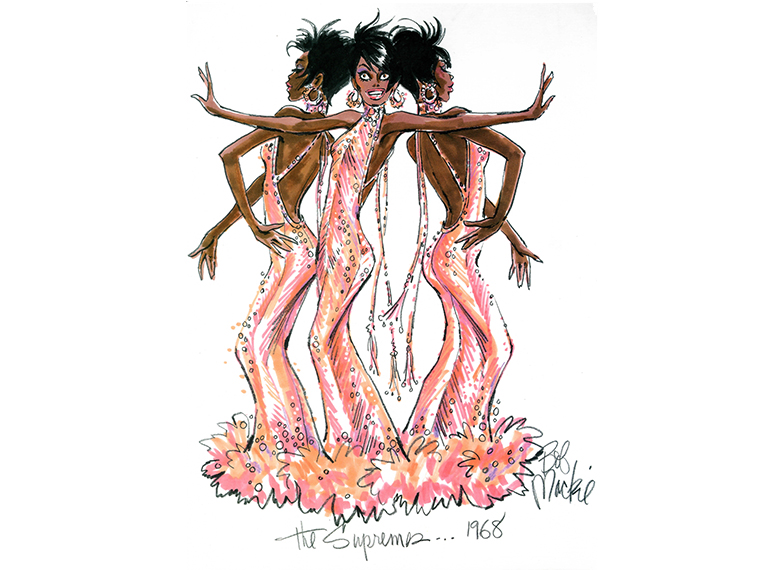
The Supremes, 1968. Courtesy of Bob Mackie
Richard Boch: Hi Bob. Walking around your exhibition at Soho Grand Gallery, I found myself experiencing the gifts of discovery, memory and rediscovery. The archival aspect of the exhibit also speaks to the great level of care and consideration for your work. How does it feel, at this stage of such a remarkable career, to see your sketches, drawings and paintings so thoughtfully presented in a gallery setting?
Bob Mackie: I’ve never been in that situation before, really, so when I read your question, I hoped I hadn’t included too much (in the show). I’ve had things on exhibit before, of course, but that many things in one room—and it’s just a bit overwhelming. You know, it’s like I hate hanging my things in my own house because I’m always so critical of it and I try very hard not to take it too seriously.
RB: I often wonder how we become so critical of our own work. It’s amazing to me.
BM: Well, you just do—you can’t help it. It’s just one of those things.
RB: Early in your career, you worked up the original sketches for Jean Louis’ design that became the dress Marilyn Monroe wore to President Kennedy’s birthday celebration.
BM: That was very early. I had started working, and for over a month I was just doing drawings for Marilyn (Monroe) but then they fired her from Fox (Studios) and so it was kind of like, oh, ok, and we moved on to Doris Day and a few other people. I was just working with Jean Louis, so when I walked in one day, he says, This is for Marilyn. I said, What is she doing—I thought she was fired? It was just a funny moment in time and I asked, What is this for? He couldn’t tell me, so I didn’t really know until a couple of weeks later. Then I saw pictures in the paper of the event itself, and Marilyn singing “Happy Birthday, Mr. President,” that I realized what the whole thing was about.
RB: What a brilliant, brilliant opportunity for you.
BM: Well, I mean, I didn’t design it. I just did what he asked me to do—that was my job at that time because I had just started in the business. And the funny thing is, I never saw those sketches again for maybe twenty or thirty years when I saw them on television being presented for auction!
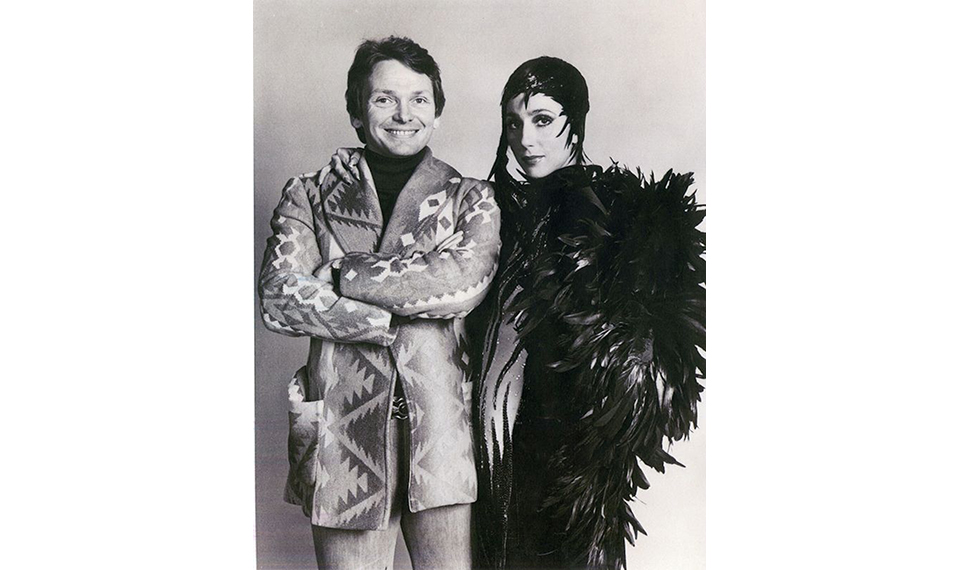
Bob and Cher. Courtesy of Bob Mackie
RB: Let’s talk a bit about what it was like when you found yourself taking your work to the next level. When decades later, you created the unforgettable designs Cher wore to the Academy Awards. Between the sketches for the Marilyn Monroe dress and the collaborations with Cher, they seem to speak to a belief that being noticed and artistic vision are of equal importance. Am I reading that correctly? Do you agree?
BM: Well, I think so, but the thing is, I walked into a fitting with Cher and I had never met her. I’d just seen pictures of her and this was early on when she appeared on the Carol Burnett Show. It was the first season and Cher walked in, and I thought, Oh she’s so much more beautiful than I ever expected. I expected this girl who wasn’t particularly beautiful or really anything, and then I looked, I said to myself, I could do a lot with her. Sometimes you look at people like that and you know they’re ready. They’re just ready!
RB: They’re ready. That’s such a wonderful observation. It’s really just so perfect.
BM: Well, you know, I always said that there are these performers, they come out of the womb ready to sing and dance and tell jokes—and they’re ready—they’re absolutely ready.
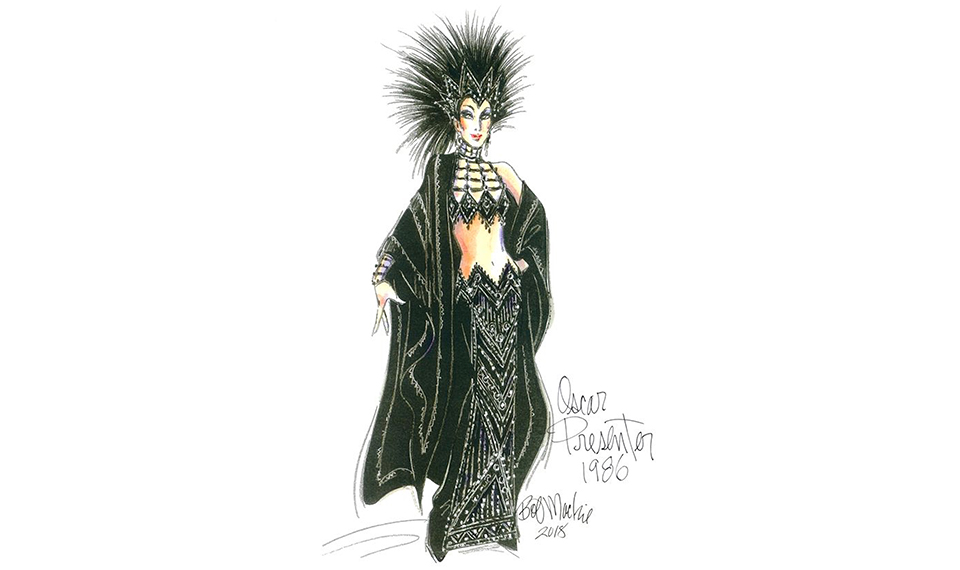
Cher, Academy Award Presenter 1986. Courtesy of Bob Mackie
RB: So, another very real question for me, and one that so many others surely want to ask—what was it like putting your head together with Cher and creating designs that we still talk about today?
BM: Well, this is a girl that grew up in a household where her mother was a starlet in Hollywood and did a lot of work modeling—bathing suits and pinup. So, when your mother was a woman who could just walk in and sit down and look beautiful, it didn’t occur to Cher to be anything but perfect and gorgeous.
RB: So, what kind of collaborative effort was it like for you and Cher? I mean, in the case of designing for the Academy Awards, she was a presenter in 1986, and she won Best Actress in 1988. Was there a back-and-forth between the two of you?
BM: Well, for a moment (1986), I said to her, What are you thinking? You’re giving an award to an actor. We didn’t even know who it was yet. Are you sure you want to get this dressed up because you might be pulling too much focus. To which she said, He’ll be fine!
RB: And Don Ameche wound up winning Best Supporting Actor for Cocoon…
BM: Yes, and Don said if Cher hadn’t been dressed like that, his picture with her wouldn’t have been on the front page of the newspaper!
RB: Well, there you go.
BM: Yeah. Every year that photo is still printed somewhere—believe me, for the last who knows how many years.
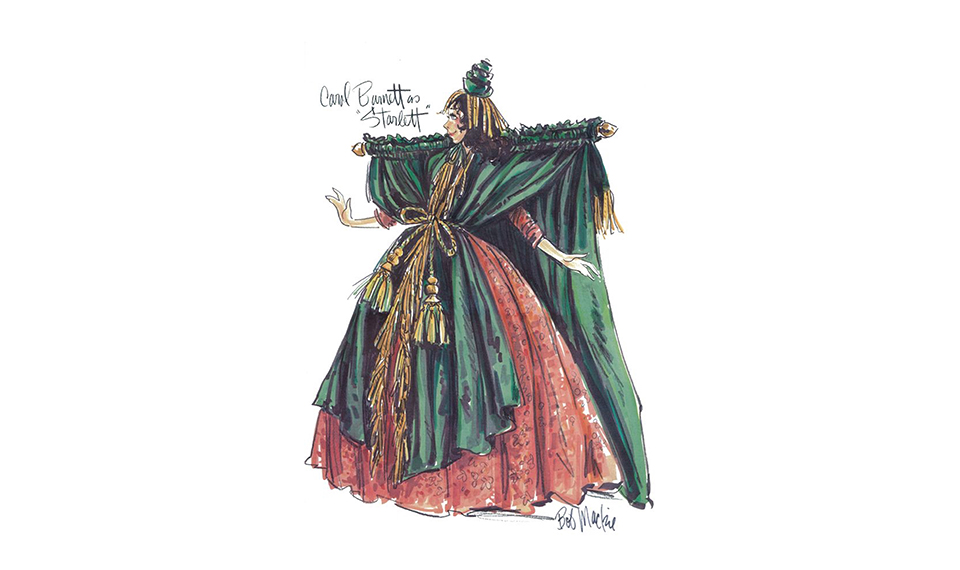
Carol Burnett as Starlett aka Scarlett O’Hara. Courtesy of Bob Mackie
RB: Then there’s the Carol Burnett Show that ran for eleven seasons, 1967-1978. It was an innovative comedy milestone and you designed every costume, over 15,000, for the entire ensemble cast. Those years alone would’ve been enough to make anyone’s career.
BM: But how lucky for me as the designer. I mean, those performers, those comedy performers—Tim Conway—just amazing! And Vicki Lawrence was just out of high school and brilliant. You know she learned it all being coached by Harvey Korman. He taught her dialect and accent and all kinds of things that she would never have known otherwise.
RB: And I mean, those costumes, really—The Went With The Wind Dress with the window drapes and Carol Burnett as Starlett aka Scarlett O’Hara. That costume is now in the Smithsonian.
BM: Well, that was the hardest, really, because everybody had seen the movie by that time and they knew that the joke was already there. I thought, Where do I go now? What do I do now? Somehow it just worked out beautifully.
RB: You’ve worked with Diana Ross, Elton John, Liza Minnelli and Madonna. And you’ve worked with Miley Cyrus, Pink and RuPaul—that’s just the shortlist. You’ve been deep in the mix of American popular culture for nearly your entire life. What does it mean to you, knowing that you’ve contributed so much, and how much that contribution means to the people who love you?
BM: You know, there are people that are just waiting for that moment to look a special way. Like Elton said to me, I’d like some costumes to wear like Cher gets to wear—and I said, Well, what is it you’re thinking? And he said, Like what she wears. And I said, Ok, whatever! And he still says his career would never have been the same if he hadn’t started dressing up. And then when RuPaul came to see me, I thought, Well, this will be fun. I knew that he was dressing up a little bit in drag. And you know it was really fun, and he sat down and told me everything that I had ever done for Diana Ross and Diahann Carroll and Tina Turner. He knew everything that I’d ever done for anybody that he admired…. So we just had the best time. And I still love seeing him from time to time. And how many Emmys has he won in the last couple of years—oh my god!
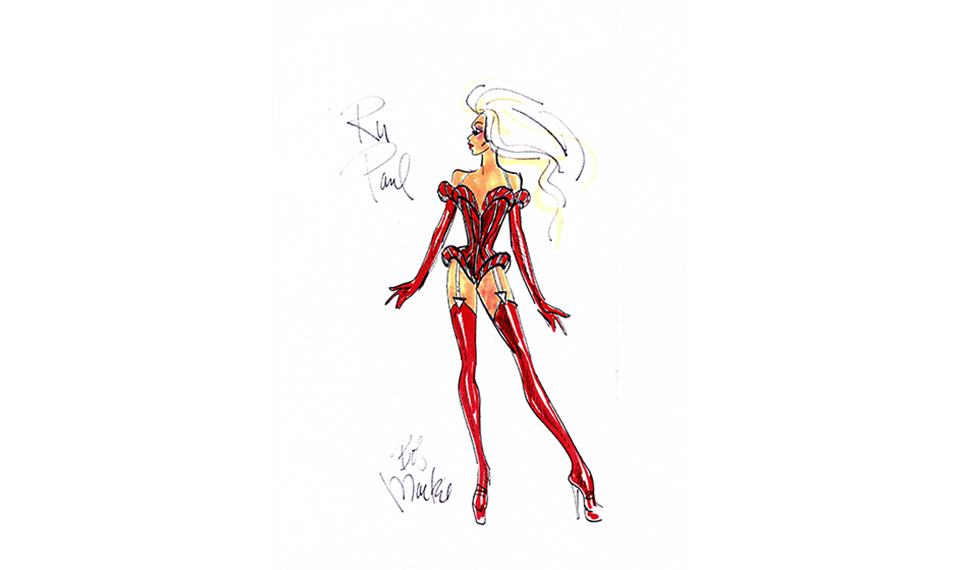
RuPaul. Courtesy of Bob Mackie
RB: Thinking about your work, is it the idea of what you do, the actual craft or the person you’re collaborating with that offers you the greatest inspiration? Or is it a combination of all those things that really drives you creatively?
BM: Well, I was always glad I was doing that kind of work. When I was like six or seven or eight years old, I loved going to the movies. I loved the musicals. I loved the production numbers; that was my favorite thing. It was just the odd thing (at first), and then when I finally got older, a little bit older, early teenage years, or whatever, I would see An American in Paris or Singin’ In The Rain, and I thought, these are really good movies. I love comedy and I was like, I could do that, and, why not? It never occurred to me, however, to do a Western, although I did end up doing a couple.
RB: You’ve won nine Primetime Emmy Awards, received three Academy Award Nominations and won The Tony Award for Costume Design in 2019. You’ve really done it and then some—so tell me, what is it that keeps you going?
BM: It’s all just fun. It’s fun when the performer is exciting and fun to watch the ones that know how to do it—they were just born knowing how to do it, how to work an audience, how to be exciting for that audience.
RB: From what I’ve been reading, seeing and hearing about From Sketches to Spotlight at Soho Grand Gallery, the exhibition is casting a wide net of appeal. The best part being that both fans and admirers, as well as a new younger crowd that are just getting to know you and the work, come away with a real sense and awareness of Bob Mackie—the designer, the artist and the fashion icon. What do you think about all that? Any last thoughts?
BM: You know, as a kid, I didn’t play baseball or football or any of that stuff—I couldn’t be bothered. I loved movies and movies about show business. I love movies where people get on a train and go to Detroit or Philadelphia and then end up in New York City. You know, it’s just the way it was, and is. This I what I like in life.
RB: Really enjoyed talking to you, Bob. Thank you so much. You know the show is going to run through the end of August, so that’s exciting.
BM: Well, that’s good. Everybody likes a long run. It’s just one of those things.
***
Bob Mackie: From Sketches to Spotlight is on view at Soho Grand Gallery through August 31, 2025.
INTERVIEW Richard Boch / IMAGERY Courtesy of Bob Mackie
Richard Boch writes GrandLife’s New York Stories column and is the author of The Mudd Club, a memoir recounting his time as doorman at the legendary New York nightspot, which doubled as a clubhouse for the likes of Jean-Michel Basquiat, Keith Haring, Debbie Harry and Talking Heads among others. To hear about Richard’s favorite New York spots for art, books, drinks, and more, read his Locals interview—here.